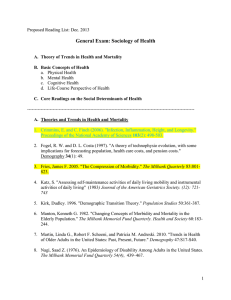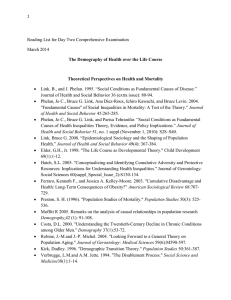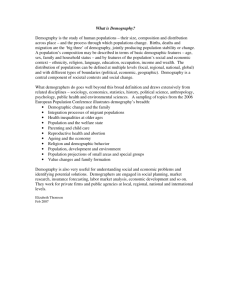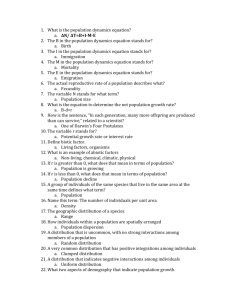General reading (spring 16)
advertisement
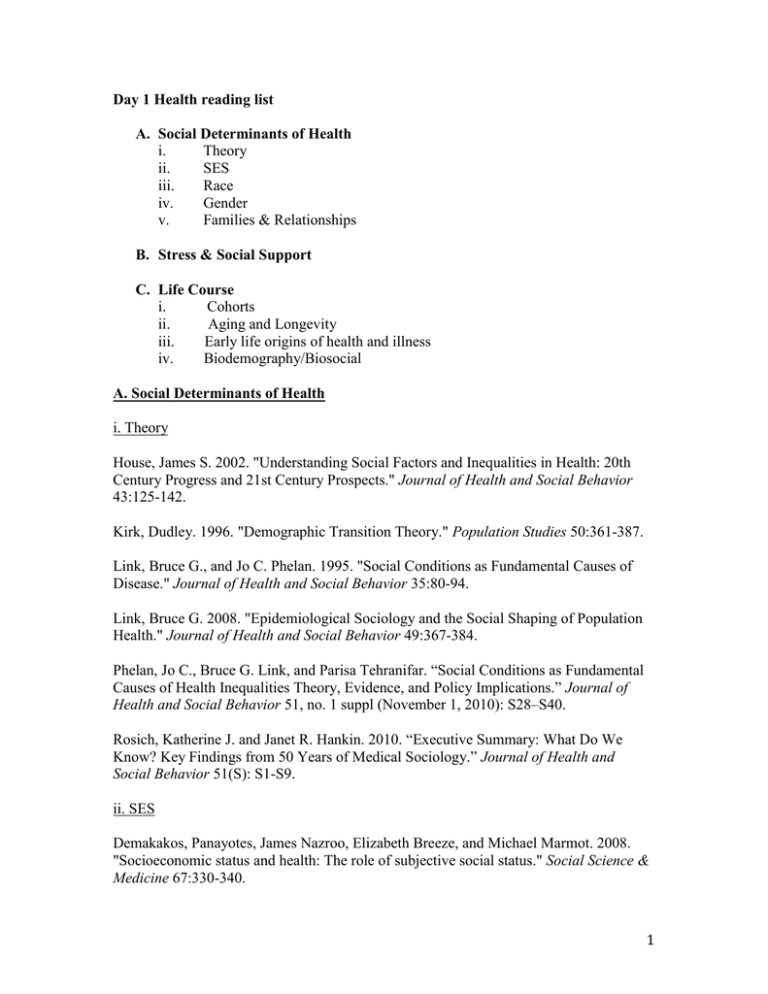
Day 1 Health reading list A. Social Determinants of Health i. Theory ii. SES iii. Race iv. Gender v. Families & Relationships B. Stress & Social Support C. Life Course i. Cohorts ii. Aging and Longevity iii. Early life origins of health and illness iv. Biodemography/Biosocial A. Social Determinants of Health i. Theory House, James S. 2002. "Understanding Social Factors and Inequalities in Health: 20th Century Progress and 21st Century Prospects." Journal of Health and Social Behavior 43:125-142. Kirk, Dudley. 1996. "Demographic Transition Theory." Population Studies 50:361-387. Link, Bruce G., and Jo C. Phelan. 1995. "Social Conditions as Fundamental Causes of Disease." Journal of Health and Social Behavior 35:80-94. Link, Bruce G. 2008. "Epidemiological Sociology and the Social Shaping of Population Health." Journal of Health and Social Behavior 49:367-384. Phelan, Jo C., Bruce G. Link, and Parisa Tehranifar. “Social Conditions as Fundamental Causes of Health Inequalities Theory, Evidence, and Policy Implications.” Journal of Health and Social Behavior 51, no. 1 suppl (November 1, 2010): S28–S40. Rosich, Katherine J. and Janet R. Hankin. 2010. “Executive Summary: What Do We Know? Key Findings from 50 Years of Medical Sociology.” Journal of Health and Social Behavior 51(S): S1-S9. ii. SES Demakakos, Panayotes, James Nazroo, Elizabeth Breeze, and Michael Marmot. 2008. "Socioeconomic status and health: The role of subjective social status." Social Science & Medicine 67:330-340. 1 Masters, Ryan K, Robert A Hummer, and Daniel A Powers. 2012. "Educational Differences in US Adult Mortality A Cohort Perspective." American sociological review 77:548-572. Miech, Richard, Fred Pampel, Jinyoung Kim, and Richard G. Rogers. 2011. The enduring association between education and mortality: The role of widening and narrowing disparities. American Sociological Review 76(6): 913-934. Montez, Jennifer Karas, Robert Hummer, and Mark Hayward. (2011). “Educational attainment and adult mortality in the United States: A systematic analysis of functional form.” Demography. Hayward, M., Hummer, R. & I. Sasson 2015. “Trends and group differences in the association between educational attainment and U.S. adult mortality: Implications for understanding education's causal influence.” Social Science & Medicine, 127:8-18. Ross, Catherine E., Ryan K. Masters, and Robert A. Hummer. 2012. “Education and the Gender Gaps in Health and Mortality.” Demography 49 (4) (November 1): 1157–1183. iii. Race Bratter, Jenifer L., Bridget K. Gorman. 2011. Does Multiracial Matter? A Study of Racial Disparities in Self-Rated Health. Demography, 48, 127-52. Geronimus, A.T., M. Hicken, D. Keene, and J. Bound. 2006. ""Weathering" and Age Patterns of Allostatic Load Scores Among Blacks and Whites in the United States." Am J Public Health 96(5):826-833. Hayward, M. D., T. P. Miles, et al. (2000). "The Significance of Socioeconomic Status in Explaining the Racial Gap in Chronic Health Conditions." American Sociological Review 65(6): 910 -930. Hummer, Robert. 1996. "Black-White Differences in Health and Mortality: A Review and Conceptual Model." The Sociological Quarterly 37:105-125. Lariscy, Joseph T., Robert A. Hummer, Mark D. Hayward. 2014. Hispanic Older Adult Mortality in the United States: New Estimates and an Assessment of Factors Shaping the Hispanic Paradox. Demography [Epub ahead of print] Masters R, Hummer RA, Powers DA, Beck A, Lin SF, Finch BK. 2014. Long-Term Trends in Adult Mortality for U.S. Blacks and Whites: An Examination of Period- and Cohort-Based Changes. Demography. 2014 Dec;51(6):2047-73. 2 Pais, Jeremy. 2014. Cumulative Structural Disadvantage and Racial Health Disparities: The Pathways of Childhood Socioeconomic Influence. Demography. 2014 Oct;51(5):1729-53. Powers, Daniel A. 2013. Paradox Revisited: A Further Investigation of Racial/Ethnic Differences in Infant Mortality by Maternal Age. Demography. Apr;50(2):495-520 Williams, David R. and Michelle Sternthal. 2010. Understanding Racial- ethnic Disparities in Health: Sociological Contributions. J Health Soc Behav. 2010;51 Suppl:S15-27. iv. Gender Courtenay, Will H. Constructions of masculinity and their influence on men's well-being: a theory of gender and health. Social Science & Medicine 50 (2000) 1385-1401 Gorman, B. K., et al. (2010). “Gender, Acculturation, and Health among Mexican Americans.” Journal of Health and Social Behavior 51(4): 440-457. Hill, Terrence D.; Needham, Belinda L. 2013. "Rethinking gender and mental health: A critical analysis of three propositions.” Social Science & Medicine 92:83-91. Montez, J.K. and A. Zajacova. 2013. “Explaining the Widening Education Gap in Mortality among U.S. White Women.” Journal of Health and Social Behavior 54:166182. Jen'nan Ghazal Read and Bridget K. Gorman. 2010. “Gender and Health Inequality.” Annual Review of Sociology. Vol. 36: 371-386. Springer KW, Hankivsky Olena, Bates Lisa M. “Gender and health: Relational, intersectional, and biosocial approaches.” Soc Sci Med. 2012 Jun;74(11):1661-6. Pudrovska T, Reither EN, Logan ES, Sherman-Wilkins KJ. “Gender and reinforcing associations between socioeconomic disadvantage and body mass over the life course.” J Health Soc Behav. 2014 Sep;55(3):283-301 Pudrovska T, Karraker A. “Gender, job authority, and depression.” J Health Soc Behav. 2014 Dec;55(4):424-41. T Pudrovska, D Carr, M McFarland, C Collins “Higher-status occupations and breast cancer: A life-course stress approach.” Social Science & Medicine, 2013 v. Families & Relationships Carr, D., & Springer, K. 2010. Advances in Families and Health Research in the 21st Century. 3 House, James S., Karl R. Landis, and Debra Umberson. 1988. "Social relationships and health." Science 241:540. McFarland, Michael J., Mark D. Hayward, and Dustin Brown. 2013. "I've Got You under My Skin: Marital Biography and Biological Risk." Journal of Marriage and Family 75:363-380. Thomeer, M. B., et al. (2013). "Marital Processes around Depression: A Gendered and Relational Perspective." Society and Mental Health 3(3): 151-169. Umberson, D. et al. (2006). You make me sick: Marital quality and health over the life course. Journal of Health and Social Behavior. 47: 1-16 Umberson D, Pudrovska T, Reczek C. 2010. Parenthood, Childlessness, and Well-Being: A Life Course Perspective. J Marriage Fam. 2010 Jun;72(3):612-629. Umberson, Debra, Robert Crosnoe, and Corinne Reczek. 2010. "Social Relationships and Health Behavior across the Life Course." Annual Review of Sociology 36: 139-157. Umberson, D., et al. (2014). "Race, Gender, and Chains of Disadvantage: Childhood Adversity, Social Relationships, and Health." Journal of Health and Social Behavior 55(1): 20-38. Umberson, Debra and Jennifer Karas Montez. 2010. Social Relationships and Health: A Flashpoint for Health Policy. J Health Soc Behav. 2010; 51(Suppl): S54–S66. Williams, Kristi. 2003. Has the Future of Marriage Arrived? A Contemporary Examination of Gender, Marriage, and Psychological Well-Being. Journal of Health and Social Behavior, Vol. 44, No. 4 (Dec., 2003), pp. 470-487 Yang, Y. C., et al. (2013). "Social Isolation and Adult Mortality: The Role of Chronic Inflammation and Sex Differences." Journal of Health and Social Behavior 54(2): 183203. B. Stress and Social Support Almeida, David M. et al. 2005. “Do Daily Stress Processes Account for Socioeconomic Health Disparities?” The Journals of Gerontology Series B: Psychological Sciences and Social Sciences 60B, Special Issue II (2005): S34-39. Pearlin, Leonard I., Scott Schieman, Elena M. Fazio, and Stephen C. Meersman. 2005. "Stress, Health, and the Life Course: Some Conceptual Perspectives." Journal of Health and Social Behavior 46:205-219. 4 Thoits, Peggy A.. 2010. Mechanisms Linking Social Ties and Support to Physical and Mental Health. Journal of Health and Social Behavior June 2011 vol. 52 no. 2 145-161. Thoits, Peggy A.. 2010. Stress and Health: Major Findings and Policy Implications. J Health Soc Behav. 2010;51 Suppl:S41-53. Turner, R. Jay, Blair Wheaton, and Donald A. Lloyd. 1995. "The Epidemiology of Social Stress" American Sociological Review 60: 104-24. Umberson, Debra, Hui Liu and Corinne Reczek (2008). “Stress and Health Behaviors.” Pp. 19-44 in Advances in Life Course Research: Stress Processes across the Life Course (Heather Turner and Scott Schiemann, Editors), Elsevier. Pudrovska T, Carr D, McFarland M, Collins C. “Higher-status occupations and breast cancer: a life-course stress approach.” Soc Sci Med. 2013 Jul;89:53-61. C. Life Course DiPrete, Thomas and Greg Eirich. 2006. “Cumulative Advantage as a Mechanism for Inequality: A Review of Theory and Evidence.” Annual Review of Sociology 32:271–297. Elder, Glen H., Monica Kirkpatrick Johnson, Robert Crosnoe, Jeylan T. Mortimer, and Michael J. Shanahan. 2003. "The Emergence and Development of Life Course Theory." Pp. 3-19, Handbooks of Sociology and Social Research: Springer US. Hatch, Stephani L. 2005. "Conceptualizing and Identifying Cumulative Adversity and Protective Resources: Implications for Understanding Health Inequalities." Journals of Gerontology Series B: Psychological Sciences & Social Sciences 60B:130-134. Willson, Andrea, Kim M. Shuey, and Glen H. Elder, Jr. 2007. "Cumulative Advantage Processes as Mechanisms of Inequality in Life Course Health." The American Journal of Sociology 112:1886-1924. i. Cohorts Lauderdale Diane S. “Education and Survival: Birth Cohort, Age and Period Effects.” Demography. 2001;38:551–61. Lynch Scott M. “Cohort and Life-Course Patterns in the Relationship between Education and Health: A Hierarchical Approach.” Demography. 2003;40:309–331. Masters RK, Reither EN, Powers DA, Yang YC, Burger AE, Link BG. 2013. “The impact of obesity on US mortality levels: the importance of age and cohort factors in population estimates.” Am J Public Health. 2013 Oct;103(10):1895-901, with commentary 5 Yang, Yang. 2008. “Trends in U.S. Adult Chronic Disease Mortality: Age, Period, and Cohort Variations.” Demography 45:387-416. ii. Aging and longevity Gee, Gilbert C., Eliza K. Pavalko and J. Scott Long. 2007. “Age, Cohort and Perceived Age Discrimination: Using the Life Course to Assess Self-Reported Age Discrimination.” Social Forces 86(1):265-90 Mirowsky, John. Cognitive Decline and the Default American Lifestyle. Journals of Gerontology: Social Sciences. 2011 Jul;66 Suppl 1:i50-8. Yang, Yang and Linda C. Lee. “Dynamics and Heterogeneity in the Process of Human Frailty and Aging: Evidence from the U.S. Older Adult Population.” Journals of Gerontology: Social Sciences, 65(B): 246-255. iii. Early-Life Origins of Health and Illness Blackwell, Debra L., Mark D. Hayward, and Eileen M. Crimmins. 2001. "Does childhood health affect chronic morbidity in later life?" Social Science & Medicine 52:1269-1284. – Case Anne, Christina Paxson. Causes and Consequences of Early-Life Health. Demography. 2010;47:S65–S85. McFarland, Michael and Mark Hayward 2014. “Poverty and Awakening Cortisol in Adolescence: The Importance of Timing in Early Life.” Society and Mental Health 41:21-37. Montez, Jennifer Karas, and Mark D. Hayward. 2014. “Cumulative Early-Life Adversity, Educational Attainment, and Active Life Expectancy among U.S. Adults.” Demography 51(2): 413-435. Palloni, Alberto, Carolina Milesi, Robert G. White, and Alyn Turner. 2009. "Early childhood health, reproduction of economic inequalities and the persistence of health and mortality differentials." Social Science & Medicine 68:1574-1582. Pudrovska, T. 2014. “Early-Life Socioeconomic Status and Mortality at Three Life Course Stages: An Increasing Within-Cohort Inequality.” Journal of Health and Social Behavior 55(2): 181-195. iv. Biodemography/Biosocial Caspi, Avshalom et al. 2003. Influence of Life Stress on Depression: Moderation by a Polymorphism in the 5-HTT Gene. Science. 2003 Jul 18;301(5631):386-9. 6 Crimmins E, Kim JK, Vasunilashorn S. 2010. Biodemography: new approaches to understanding trends and differences in population health and mortality. Demography. 2010;47 Suppl:S41-64. Crimmins, Eileen M., Jung Kim, and Teresa Seeman. 2009. “Poverty and Biological Risk: The Earlier ‘Aging’ of the Poor.” Journal of Gerontology: Medical Sciences 64A(2):286–292. Boardman, J.D., Blalock, C., & F. Pampel. 2010 “Trends in the Genetic Influences on Smoking.” Journal of Health and Social Behavior, 51(1) 108-123. 7

